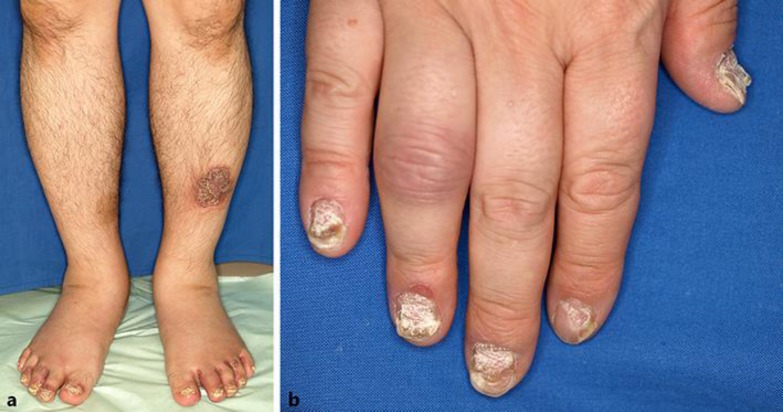Abstract
A 42-year-old Japanese man presented with persistent headache during treatment for psoriatic arthritis (PsA) with infliximab. Treatment with infliximab was initiated 3 years before and the psoriatic skin lesions with arthritis were well controlled. However, after 21 doses of infliximab, the skin lesions and joint pain exacerbated and became intractable. Ten days after the dosage of infliximab was increased, the patient experienced headache and nausea with high fever. He had scaly, well-circumscribed erythemas on his trunk, extremities, and deformed nails. He also had swelling and pain in multiple joints. His complete blood and differential leukocyte counts were normal. The level of C-reactive protein was 16.66 mg/dL, whereas anti-infliximab antibodies were absent. Nuchal rigidity was absent and there were no abnormal neurological findings; however, jolt test results were positive. Results from magnetic resonance imaging were normal, whereas those from cerebrospinal fluid (CSF) examination were almost normal. The CSF contained mononuclear cells and was negative for bacteriological cultures, India ink staining, and polymerase chain reaction amplification of herpesvirus group DNA. Headache and nausea improved 2 months after infliximab was discontinued. The patient failed to respond to infliximab treatment for PsA, and we diagnosed infliximab-induced aseptic meningitis. Infliximab was discontinued and treatment with ustekinumab and methotrexate was initiated. Thereafter, the psoriatic skin lesion and joint pain gradually improved. Infliximab-induced aseptic meningitis may be a differential diagnosis when symptoms of meningitis develop during infliximab administration.
Keywords: Infliximab, Psoriasis, Psoriatic arthritis, Aseptic meningitis, Tumor necrosis factor-α
Case Presentation
A 42-year-old Japanese man presented with persistent headache during treatment for psoriatic arthritis (PsA) with infliximab. He was diagnosed with PsA 10 years before. Treatment with infliximab (5 mg/kg) was initiated 3 years before, and the psoriatic skin lesions with arthritis were well controlled. However, after 21 doses of infliximab, the skin lesions and joint pain exacerbated and became intractable, even after the dosage of the infliximab was increased to 6.25 mg/kg. Ten days after the dosage was increased, the patient experienced headache and nausea with a high fever of 38°C. He had scaly, well-circumscribed erythemas (2–5 cm in diameter) on his trunk, extremities, and deformed nails (Fig. 1a, b). He also had swelling and pain in multiple joints. His complete blood and differential leukocyte counts were normal. The level of C-reactive protein (CRP) was 16.66 mg/dL (normal value is <0.30 mg/dL) and the erythrocyte sedimentation rate was >100 mm/h (the normal value is <15 mm/h), whereas anti-infliximab antibodies were absent. His Disease Activity Score (DAS) 28-CRP was 5.46, indicating that the arthritis was severe. His headache was pulsatile and persisted all day. The high fever was remittent and 38°C at night. Nuchal rigidity was absent and there were no abnormal neurological findings; however, jolt test results were positive. Results from magnetic resonance imaging were normal, whereas those from cerebrospinal fluid (CSF) examination were almost normal. The CSF was colorless and transparent, with initial pressure of 17 cmH2O, cell count of 3/μL, total protein of 22.8 mg/dL, and glucose level of 88 mg/dL. The CSF contained mononuclear cells and was negative for bacteriological cultures, India ink staining, and polymerase chain reaction amplification of herpesvirus group DNA. The results indicated that bacterial, cryptococcal, and herpesvirus-induced meningitides were absent. Headache and nausea improved 2 months after infliximab was discontinued. The patient failed to respond to infliximab treatment for PsA, and we diagnosed infliximab-induced aseptic meningitis. Infliximab was discontinued and treatment with ustekinumab (45 mg) and methotrexate (12 mg/week) was initiated. Thereafter, the psoriatic skin lesion and joint pain gradually improved and DAS28-CRP decreased from 5.46 to 3.43 after the third injection of ustekinumab.
Fig. 1.
Clinical appearance just before the treatment with ustekinumab and methotrexate. a The patient manifested with scaly well-circumscribed erythemas (2–5 cm in diameter) on his trunk and extremities. The psoriasis area severity index was 5.0. b All nails of the hands and feet of the patient were thickened, deformed, and coarse. He also manifested with swelling and pain in multiple small and large joints including the proximal interphalangeal joints of his right fourth finger, right third toe, and left second toe, and pain in multiple interphalangeal joints of his feet, bilateral hip joints, and bilateral ankle.
Aseptic meningitis can be induced by several drugs including nonsteroidal antiinflammatory drugs, antimicrobials, and infliximab [1,2,3]. The 2 proposed mechanisms of drug-induced aseptic meningitis are direct irritation of the meninges owing to intrathecal administration of the drug and immunological hypersensitivity to the drug [1]. An alternative explanation for infliximab-induced meningitis is the inhibition of peripheral tumor necrosis factor-α (TNF-α). This can lead to the enhanced action of brain-derived TNF-α, which could lead to side effects in the central nervous system. A diagnosis of infliximab-induced aseptic meningitis is required to exclude infectious meningitides [4]. The role of anti-infliximab antibodies in the pathogenesis of infliximab-induced aseptic meningitis and their association with second failure of infliximab treatment are unclear [5]. Infliximab-induced aseptic meningitis may be a differential diagnosis when symptoms of meningitis develop during infliximab administration.
Statement of Ethics
The authors have no ethical conflicts to disclose.
Disclosure Statement
The authors have no conflicts of interest to disclose.
References
- 1.Jolles S, Sewell WA, Leighton C. Drug-induced aseptic meningitis: diagnosis and management. Drug Saf. 2000;22:215–226. doi: 10.2165/00002018-200022030-00005. [DOI] [PubMed] [Google Scholar]
- 2.Marotte H, Charrin JE, Miossec P. Infliximab-induced aseptic meningitis. Lancet. 2001;358:1784. doi: 10.1016/S0140-6736(01)06810-6. [DOI] [PubMed] [Google Scholar]
- 3.Kashyap AS, Kashyap S. Infliximab-induced aseptic meningitis. Lancet. 2002;359:1252. doi: 10.1016/s0140-6736(02)08241-7. [DOI] [PubMed] [Google Scholar]
- 4.Hegde N, Gayomali C, Rich MW. Infliximab-induced headache and infliximab-induced meningitis: two ends of the same spectrum? South Med J. 2005;98:564–566. doi: 10.1097/01.SMJ.0000155499.21189.75. [DOI] [PubMed] [Google Scholar]
- 5.Shah R, Shah M, Bansal N, Manocha D. Infliximab-induced aseptic meningitis. Am J Emerg Med. 2014;32:1560. doi: 10.1016/j.ajem.2014.05.045. e1563–e1564. [DOI] [PubMed] [Google Scholar]



